The evolution of bicycles
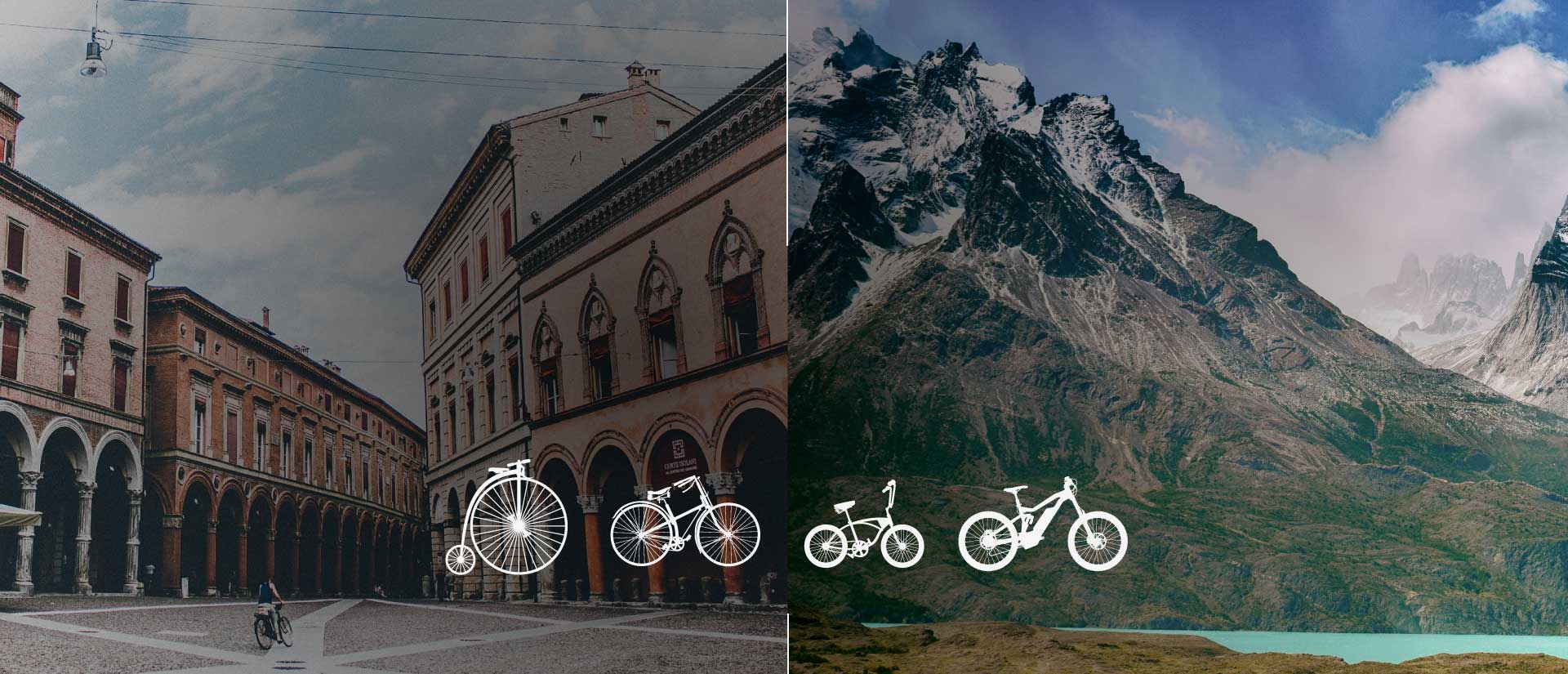
Victorians with bicycles – can we say that they were the actual original hipsters? Long before the men with fancy beards in vintage clothes we know today, there were men with nicely shaped beards and stylish clothes on velocipede and penny farthing. But like fashion; bicycles also changed a lot over the time. While once the car was the transportation of the future, nowadays cyclist and a steady growth of bike lanes are the new picture of most cities in today’s world. Don’t underestimate the meaning of the bike; its development brought the first humanly powered two-wheel transportation. It’s a symbol for progress, fun and entertainment as well as freedom and pleasure. But bicycles also embody hope and are suited for a future facing huge problems like the climate change, obesity or the endless growth of our population – mostly in today’s megacities. Without any doubts, bikes made an impressive evolution from their start as hobbyhorse to what they are today.
1800-1830Although there are some questionable arguments about the existence of bikes before 1800, it’s a widely acknowledged fact that the first bike was invented 1817... Read more |
1840-1870In 1860s Pierre Michaux, founder of the company Michaux, developed the first commercial bicycle which was equipped with pedals and cranks at the front wheel... Read more |
1880-1910With bigger front wheels you are able to increase your speed, so consequently the front wheel got bigger and bigger whereas the back wheel got so small... Read more |
1920-1950During this time the world population started to focus more on the production of cars, pushing bikes more and more into the background. After the Roaring Twenties there was the... Read more |
1960-1990After World War I & II and the Great Depression the 1960s smoothed the ways for the “Swinging Sixties” and the psychedelic seventies. These moments were really defining... Read more |
2000-todayToday many cities are supporters of cycling and they try to offer a good infrastructure for cyclists. More and more people use bicycles to stay fit and move around the city... Read more |
1800 - 1830
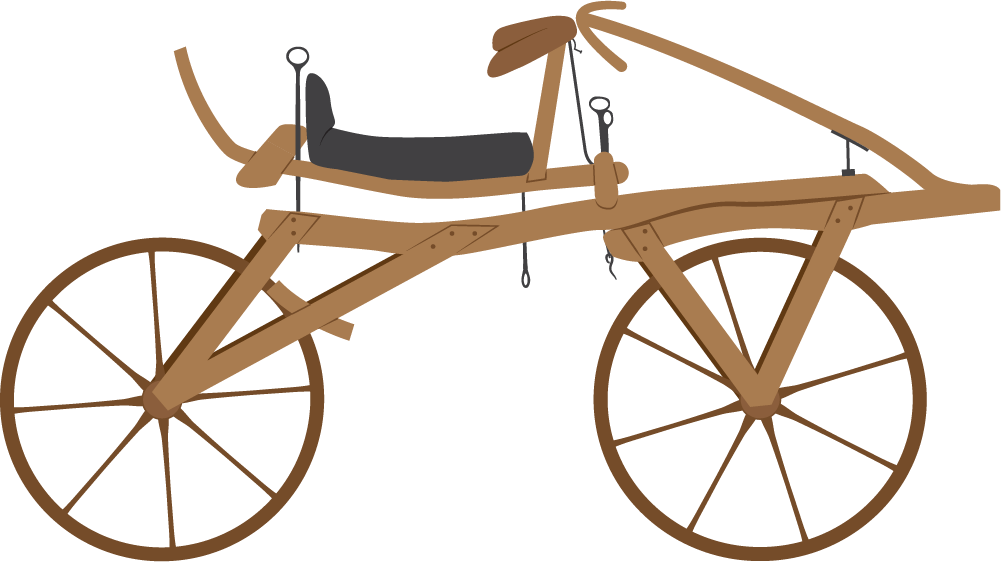 The invention of the first bicycle
Although there are some questionable arguments about the existence of bikes before 1800, it’s a widely acknowledged fact that the first bike was invented 1817 by Baron Karl von Drais in Germany. It was known as `walkingmachine´ or Draisine and in the year of 1818 it got patented as the first successful humanly powered two-wheel transportation.
Of course other inventors picked up this concept, especially Denis Johnson from London, who invented a modified version of the original. His version was mostly made out of wood with a steerable front wheel. His version was able to cut down peoples’ travelling time by almost 50%. This two-wheeler had no pedals so the drivers had to actuate their hobbyhorse in a very adventurous way with their feet while trying to keep their balance riding downhill.
Between 1818 and 1820 owning a velocipede was the biggest trend that affected North America and Western Europe. The population celebrated the innovation as newly fashionable product, which you had to own – especially if you lived in the high society of London. But only a few years later the popularity of the velocipede began to fade and some cities even banned the use of two-wheelers completely because of the high number of accidents between riders and pedestrians.
The invention of the first bicycle
Although there are some questionable arguments about the existence of bikes before 1800, it’s a widely acknowledged fact that the first bike was invented 1817 by Baron Karl von Drais in Germany. It was known as `walkingmachine´ or Draisine and in the year of 1818 it got patented as the first successful humanly powered two-wheel transportation.
Of course other inventors picked up this concept, especially Denis Johnson from London, who invented a modified version of the original. His version was mostly made out of wood with a steerable front wheel. His version was able to cut down peoples’ travelling time by almost 50%. This two-wheeler had no pedals so the drivers had to actuate their hobbyhorse in a very adventurous way with their feet while trying to keep their balance riding downhill.
Between 1818 and 1820 owning a velocipede was the biggest trend that affected North America and Western Europe. The population celebrated the innovation as newly fashionable product, which you had to own – especially if you lived in the high society of London. But only a few years later the popularity of the velocipede began to fade and some cities even banned the use of two-wheelers completely because of the high number of accidents between riders and pedestrians.
More than just a hobbyhorse Between 1818 and 1820 owning a velocipede was the biggest trend that affected North America and Western Europe. The population celebrated the innovation as newly fashionable product, which you had to own – especially if you were a part of the high society in London. But only a few years later the popularity of the velocipede began to fade and some cities even banned the use of two-wheelers completely because of the high number of accidents between riders and pedestrians. Between 1820 and 1850 many changes which based on the idea of a humanly powered transportation happened. For example new models with three or four wheels in different shapes and heights with some extra features like pedals or cranks were invented.
Top
1840 - 1870
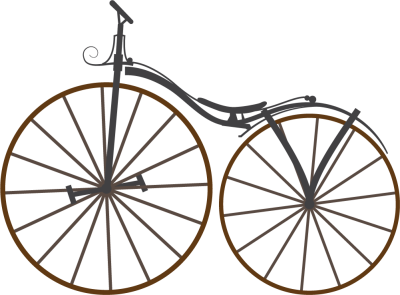 Pedals and Cranks
In 1860s Pierre Michaux, founder of the company Michaux, developed the first commercial bicycle which was equipped with pedals and cranks at the front wheel. Now you were able to move your bike forward while pedalling. Over night the bike became a huge success and for a short amount of time it was the new trend everybody needed to have. But there were some disadvantages to it; the use of a heavy metal frame and iron wheels made the bike incredible heavy and chunky. Bikes like this could easily weight up to 50 kilos. Also the front wheel was bigger than the back one.
These bicycles were very uncomfortable and hard to handle although they were armed with spring saddles.
Soon some modifications were made, tires to replace the iron wheels and improve the movement of the pedals or even bicycles with more than two wheels were invented. The number of inventors who tried to develop the perfect and most efficient transportation increased a lot.
Pedals and Cranks
In 1860s Pierre Michaux, founder of the company Michaux, developed the first commercial bicycle which was equipped with pedals and cranks at the front wheel. Now you were able to move your bike forward while pedalling. Over night the bike became a huge success and for a short amount of time it was the new trend everybody needed to have. But there were some disadvantages to it; the use of a heavy metal frame and iron wheels made the bike incredible heavy and chunky. Bikes like this could easily weight up to 50 kilos. Also the front wheel was bigger than the back one.
These bicycles were very uncomfortable and hard to handle although they were armed with spring saddles.
Soon some modifications were made, tires to replace the iron wheels and improve the movement of the pedals or even bicycles with more than two wheels were invented. The number of inventors who tried to develop the perfect and most efficient transportation increased a lot.
Success in China Today, China is known as the biggest bike nation worldwide but only thanks to officer Bin Chun, who saw the velocipede during his stay in Paris, the bike got introduced to China in the late 1860s. Shortly before that China was under western sovereignty so the idea of a new innovation from Europe wasn’t very popular. Near the end of the 19th century mainly people from abroad who lived in Shanghai at that time, made use of the bikes. Meanwhile the locals were still using the good old rickshaw. For a Chinese person in high class, it wasn’t of good standing to move around independently or even worse sweat while moving around. But one thing is clear, despite the rough start, Bin Chun actions were the impulse for the biggest bike sector worldwide.
Top
1880 - 1910
 Penny Farthing
With bigger front wheels you are able to increase your speed, so consequently the front wheel got bigger and bigger whereas the back wheel got so small it was only used as stabilizer. Around 1880 the front wheel got unbelievable big, resulting the birth of the high wheel. Because of its shape this bike was better known as "Penny Farthing", reminding the population of the common penny or farthing coins. The new bicycle got popular very fast but mostly people in the UK or US were using it. But starting the ride was really difficult; the rider had to run next to the bike and then jump on it in order to get moving. The immense height of the front wheel was the reason for many fatalities as well the difficult steering. Also riding over obstacles or using the roads in the past was extremely dangerous so there was a high chance that the unlucky rider could easily fall of this transportation.
Penny Farthing
With bigger front wheels you are able to increase your speed, so consequently the front wheel got bigger and bigger whereas the back wheel got so small it was only used as stabilizer. Around 1880 the front wheel got unbelievable big, resulting the birth of the high wheel. Because of its shape this bike was better known as "Penny Farthing", reminding the population of the common penny or farthing coins. The new bicycle got popular very fast but mostly people in the UK or US were using it. But starting the ride was really difficult; the rider had to run next to the bike and then jump on it in order to get moving. The immense height of the front wheel was the reason for many fatalities as well the difficult steering. Also riding over obstacles or using the roads in the past was extremely dangerous so there was a high chance that the unlucky rider could easily fall of this transportation.
Further developments Despite the many developments like tires and breaks the velocipede fell from is grace shortly after. At the end of 1890 the innovation of the "safety bike" with its same sized wheels was one of the biggest improvements. It's considered as the pioneer of the bike shape we are familiar today. Next to the same sized wheels it included many other key features like pedals which were linked with the back wheel through a transmission chain, gear wheels or the front wheel which was supported by a handlebar and a bicycle fork. This era is known as the "Golden Age" because not only bike developments were happening; there was also a change in society. Women who could ride bicycles where seen equivalent to men who were riding bikes, so no wonder that the bikes used by women got the nickname "object of liberty". Women were using special produced bicycles for women but they also needed special clothing to move around because the fashion style was characterized by bodices, long and heavy skirts as well s spetticoats which only limited their movements on the bikes. This new from of transportation was the start for a production of more practical and neutral clothes for women including trousers and culottes.
Top
1920 - 1950
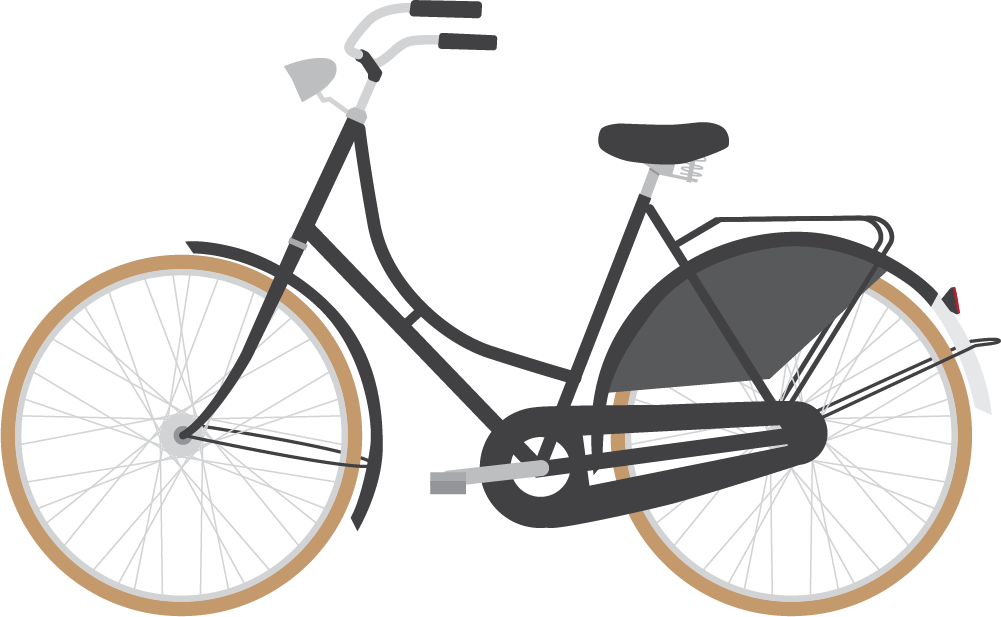 Evolution of the car - biking in the city?
During this time the world population started to focus more on the production of cars, pushing bikes more and more into the background. After the Roaring Twenties there was the Great Depression and with World War I and the Cold War the atmosphere changed a lot. In the Fifties and Sixties the worlds focus was directed at cars, which were seen as the transportation of the future, bikes were only bought for kids not for adults anymore. In cities car drivers were unsatisfied with bike riders because now cars where the preferential transportation.
In China however, the bike market was booming. At the end of 1930 the first ever assembly line factory was opened. In 1949, as China became the People's Republic of China, bikes became the main form of transportation of the citizen. Most of the people were using their bikes to get to work or do shopping trips. Since 1958 china produced more than one million bikes every year. In fact, until today, China is the main producer of bicycles with a production of more than 60% of all bikes sold worldwide.
Evolution of the car - biking in the city?
During this time the world population started to focus more on the production of cars, pushing bikes more and more into the background. After the Roaring Twenties there was the Great Depression and with World War I and the Cold War the atmosphere changed a lot. In the Fifties and Sixties the worlds focus was directed at cars, which were seen as the transportation of the future, bikes were only bought for kids not for adults anymore. In cities car drivers were unsatisfied with bike riders because now cars where the preferential transportation.
In China however, the bike market was booming. At the end of 1930 the first ever assembly line factory was opened. In 1949, as China became the People's Republic of China, bikes became the main form of transportation of the citizen. Most of the people were using their bikes to get to work or do shopping trips. Since 1958 china produced more than one million bikes every year. In fact, until today, China is the main producer of bicycles with a production of more than 60% of all bikes sold worldwide.
The return of bike races Although the first ever bike race around France was held during the turn of the century it wasn't possible to continue the race during World War II. Because of the war and the many denials of the races over such a long period of time, it wasn't clear who would be the winner of the competition. Another obstacle was the elimination of the teams from Germany and Italy (obviously because France was still at war with Italy). The route consisted of 20 to 25 stages through France, Belgium and Luxembourg and who ever managed to ride it in the shortest amount of time won this stage of the race. This format of splitting the race in different sections extended way into the 1980s. In 1953 the "dot-system" including the "green jersey" was invented. (Fun fact: they chose the colour green because their sponsor at that time was a company producing lawnmower)
Top
1960 - 1990
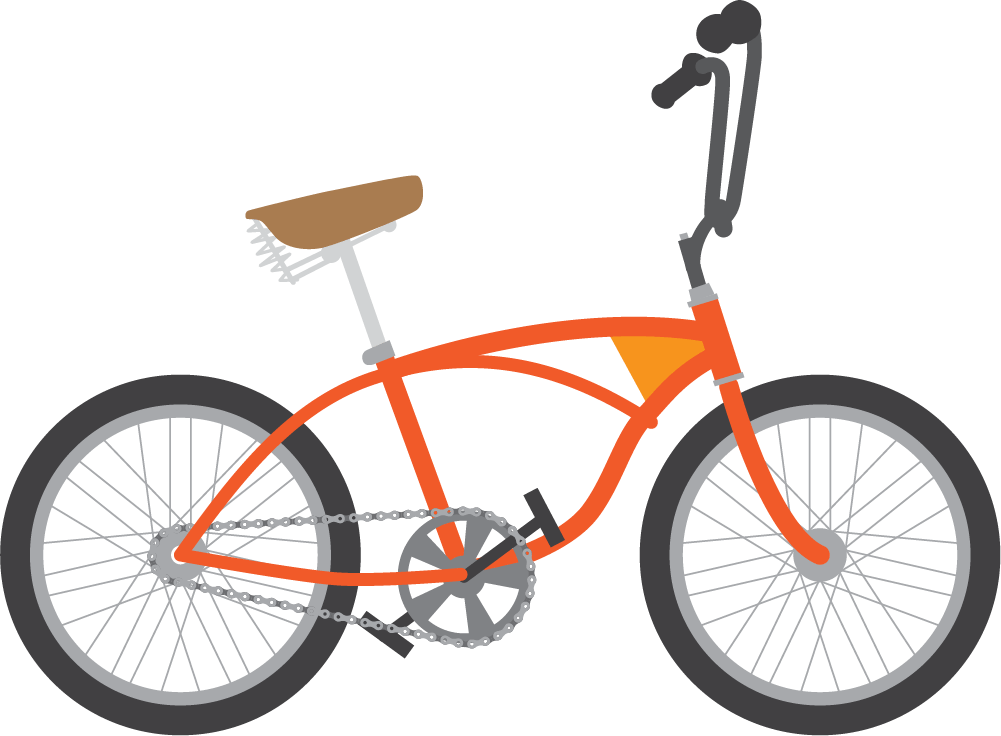 The bike boom
After World War I & II and the Great Depression the 1960s smoothed the ways for the "Swinging Sixties" and the psychedelic seventies. These moments were really defining for the time of hope, promise and freedom of expression regarding fashion, music and art. The role of women made huge improvements since the Victorian Age with Mary Quant representing a liberated generation of women. It was century made of transitions not just in the society but also in the world of bicycles.
The so called "Bike Boom" started to happen and with the increase of the importance of fitness, sale figures doubled during 1960 and 1975. During this time the BMX, whose design was inspired by motocross champions, entered the market. Its popularity increased instantly leaving a huge mark in the pop culture with several appearances in classics like ET, Karate Kid and BMX Bandits.
The bike boom
After World War I & II and the Great Depression the 1960s smoothed the ways for the "Swinging Sixties" and the psychedelic seventies. These moments were really defining for the time of hope, promise and freedom of expression regarding fashion, music and art. The role of women made huge improvements since the Victorian Age with Mary Quant representing a liberated generation of women. It was century made of transitions not just in the society but also in the world of bicycles.
The so called "Bike Boom" started to happen and with the increase of the importance of fitness, sale figures doubled during 1960 and 1975. During this time the BMX, whose design was inspired by motocross champions, entered the market. Its popularity increased instantly leaving a huge mark in the pop culture with several appearances in classics like ET, Karate Kid and BMX Bandits.
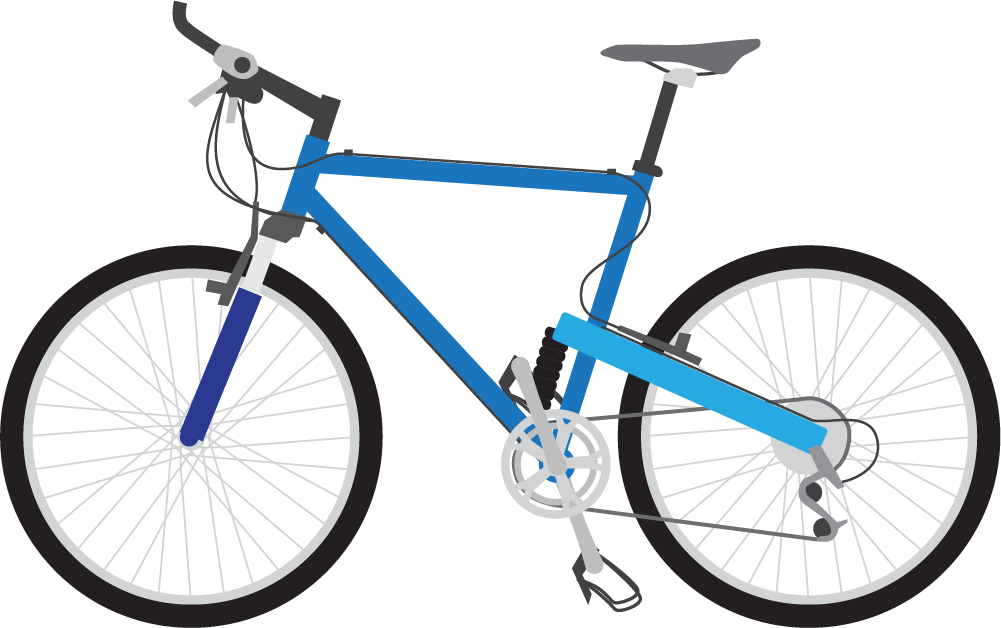 The appearance of the mountain bike
You could argue that mountain biking existed since the first days riding a bike became famous because remind yourself of the "good streets" that existed in the past - riding bikes was mountain biking at that time. But the first actual mountain bike was produced in the early 1980s. Based on the design developed by Joe Breeze, Charles Kelly and Gary Fisher, outsiders who were cruising the trails of Marin County and Mount Tamalpais, always crafting new ideas to make their bikes more resistant for rough parts through the rocky landscape.
Unfortunately, the first example of a mountain bike was not far away from the first bikes known as "pots". But the production got better and soon lightweight construction material replaced the heavy metal construction and shock absorber as well as suspension forks were integrated.
In the past only the biggest adventurer and "freaks" were brave enough to ride these paths downhill but today there are many different facets to this amazing sport.
The appearance of the mountain bike
You could argue that mountain biking existed since the first days riding a bike became famous because remind yourself of the "good streets" that existed in the past - riding bikes was mountain biking at that time. But the first actual mountain bike was produced in the early 1980s. Based on the design developed by Joe Breeze, Charles Kelly and Gary Fisher, outsiders who were cruising the trails of Marin County and Mount Tamalpais, always crafting new ideas to make their bikes more resistant for rough parts through the rocky landscape.
Unfortunately, the first example of a mountain bike was not far away from the first bikes known as "pots". But the production got better and soon lightweight construction material replaced the heavy metal construction and shock absorber as well as suspension forks were integrated.
In the past only the biggest adventurer and "freaks" were brave enough to ride these paths downhill but today there are many different facets to this amazing sport.
Top
2000 - today
 Environment, Clothing and Bike Sharing
Today many cities are supporters of cycling and they try to offer a good infrastructure for cyclists. More and more people use bicycles to stay fit and move around the city cheaper and more environmental friendly. In the early years of 2000 a movement of hipsters in places like Brooklyn or Portland started and infected almost the whole western atmosphere. High fashion labels saw this movement as opportunity to release cyclists from their latex-clothing and offer them new and stylish clothes for riding their bikes. Even regular brands started to produce cycling apparel so now everybody was able to cycle in stylish but sporty clothes.
Bike Sharing is another important concept which emerged mostly in big cities like Amsterdam, London or New York. With this program, anybody is able to cycle through the city by renting a bike and after usning it, returning it to one of the many rental places around the city.
In addition to that, the e-bike was invented in 1995. With this innovaton riding your bike got even more comfortable and easy. Even not the sportiest person is now able to ride long distances without much effort.
Environment, Clothing and Bike Sharing
Today many cities are supporters of cycling and they try to offer a good infrastructure for cyclists. More and more people use bicycles to stay fit and move around the city cheaper and more environmental friendly. In the early years of 2000 a movement of hipsters in places like Brooklyn or Portland started and infected almost the whole western atmosphere. High fashion labels saw this movement as opportunity to release cyclists from their latex-clothing and offer them new and stylish clothes for riding their bikes. Even regular brands started to produce cycling apparel so now everybody was able to cycle in stylish but sporty clothes.
Bike Sharing is another important concept which emerged mostly in big cities like Amsterdam, London or New York. With this program, anybody is able to cycle through the city by renting a bike and after usning it, returning it to one of the many rental places around the city.
In addition to that, the e-bike was invented in 1995. With this innovaton riding your bike got even more comfortable and easy. Even not the sportiest person is now able to ride long distances without much effort.
Fixie Bike - popular for Hipsters and Non-Hipsters The popularity of cycling in cities is increasing steadily so are new trends like individual production of bikes - the innovation of fixed gear bikes also known as "Fixies". It's kind of a bike representing the origin of all bicycles - a shifting gear with only one gear and without a freewheel. However there are disadvantages; you can't just "roll around". You need to keep pedalling in order to move - no matter if you're going downhill or uphill. These bikes are ideal for cycling in vities, it's a good workout but also the bike is lighter than traditional bike, which makes it easier to use public transportation like trains if you need to. But why are they so popular? Maybe because we live in a world full of mass consumption where bikes like this are the last representatives of simplicity. Hipster or not - a fixed gear bike is popular amongst a lot of people who want to experience the connection to planet earth a little more.
